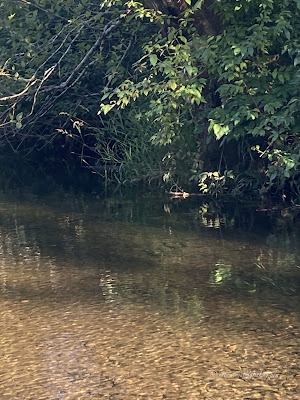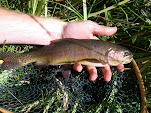After my trip up to the Methow drainage after Westslope Cutthroat in the North Cascades in Washington, I wanted hunt down some Westslope Cutthroat in the Southern Cascades of Washington this summer as well. In particular, I was hoping to find some fluvial Westslopes. One thing I strive to do on my website is represent as much of the diversity as possible in each variety of trout, such as the different life history forms. The fluvial life history forms are also known as riverine migrants and are known for making concerted migrations throughout larger river systems as well as typically reaching much larger sizes than stream resident forms. The difference in the two life history trajectories also typically results in slightly different phenotypic traits, which is why I was hoping to document the fluvial life history.
After a bit of research, I landed on a moderate sized stream that I had fished way back in 2006, but at that point the stream was dominated by small Columbia Basin Redband Trout, with Westslopes only being a rarity. Since that point, catch and release regulations have been adopted in parts of the watershed and supposedly the Cutthroat population had responded very well to the new regulations. When I mentioned my plans to my neighbor Dyllon, he was interested in joining me, so set a date on the calendar and made plans for the trip.
The day of the trip we were on the road by 5:30 AM and made good time getting over to the east side of the Cascades. As we drove up the road once we hit the stream, we were both shocked with the number of anglers out already. I had specifically chosen a stretch as it appeared to have a good concentration of pools based on satellite imagery hoping that it might hold a few large Cutthroat and luckily it was still free of anglers. . While the morning was extremely chilly, we opted to wet wade as the clear skies promised that it would be quite hot by the afternoon. Dyllon opted for a streamer setup, while I brought, my 2WT with a dry/dropper and my 6wt with a double nymph rig. Once we were rigged up, it was time to get on the water.
Dyllon took to the river first and had a few good grabs in the first hole, but it wasn't until we got to the next riffle upstream that we landed any fish. I opted for the nymph rig and after a couple casts got a good take and after a quick battle landed a beautiful fluvial Westslope Cutthroat on my October Caddis nymph.
 |
| A beautiful orange-bellied Westslope Cutthroat Trout |
After I got my Westslope, Dyllon got a nice Redband on his streamer and I picked up a couple small trout on my dry at the head of the riffle before we moved further upstream. The next stretch of the stream was a mix of riffle and pocket water habitat and turned out to be the most productive of the day. With the abundance of pocket water I grabbed my 2WT and started working up the run. The fishing was fast and furious with a fish on almost every casts and two Cutthroat (one on the dry and one on the dropper) on one of the casts. The recovery of the Westslope Cutthroat population was on full display in the section of river, as about 75% of the fish we encountered were Cutthroat. Despite the predominance of Cutthroat, it still was a mystery what would grab on each cast, and I was surprised by a couple of Chinook Salmon parr on dries in addition to the Redbands and Cutthroat.
 |
| A healthy wild Chinook Salmon parr |
Dyllon managed to get a few decent fish up to 12" and continued upstream on ahead of me. Just as Dyllon was vanishing from sight I landed a nice cast along a boulder on the far bank and saw a big flash as a nice trout grabbed my dropper. I got a solid hookset and 2WT was completely doubled over by the powerful fish. The trout stayed deep and made a number of runs before I was finally able to net a beautiful 17" fluvial Westslope Cutthroat.
 |
| A beautiful fluvial Westslope Cutthroat Trout |
The big Cutthroat managed to thoroughly put down the run, prompting me to continue moving upstream. The water for the next 1/4 mile was predominately pocket or shallow riffle water and most likely looking spots seem to produce a fish on my dry/ dropper rig.
 |
| The stream |
I linked up with Dyllon at a series of deep pools, where it was time to switch back to my nymph set up. The most productive of these pools was quite deep and required a long drift to get to where the fish were holding. This resulted in a low take to hook up ratio, but by being persistent I was rewarded with some nice Cutthroat and a beautiful Columbia Basin Redband.
 |
| A beautiful native Columbia Basin Redband Trout |
After the deep nymphing hole, we found one more productive run before we started to run into the afternoon innertube and swimmer hatch and decided to relocate. We headed downstream to where a few major tributaries came together to try our luck in some larger water. Right off the bat we found a nice run and I dredged up a beautiful 11" Westslope on my October Caddis nymph, which was definitely a good sign. After that first Cutthroat, the fishing slowed down considerably.
 |
| The second river |
We finally found some more good water about a 1/4 mile upstream, where both Dyllon and I managed to get into some more fish. For me it was another Columbia Basin Redband and a few smaller Cutthroat on my nymph rig, but Dyllon got the real surprise when he hooked into a nice fish on the streamer. I saw him hook into it from downstream and was able to reach him just in time to net a beautiful Bull Trout for him. Bull Trout are quite rare in this watershed making this a very special catch. We took extra care handling this beautiful fish and it was a joy to watch it glide back into the depths after being released.
 |
| Dyllon's surprise Bull Trout |
We covered a bit more water, but didn't find much more in the way of fish and with temperatures reaching their peak for the day we both decided to call it a day. After encountering 4 native species and finding an amazing Westslope Cutthroat fishery I am already looking forward to my next trip to the east slope of the Cascade Mountains.


























